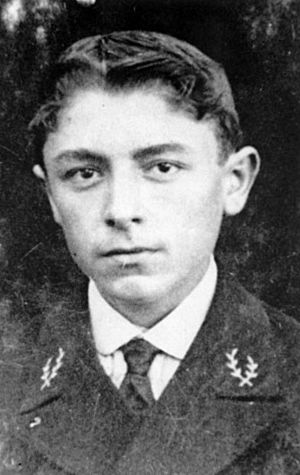Célestin Freinet facts for kids
Célestin Freinet (born October 15, 1896, in Gars, Alpes-Maritimes – died October 8, 1966, in Vence) was an important French teacher and a leader in changing how schools teach. He believed that children learn best by doing things, working together, and exploring the world around them.
Contents
Early Life and Influences
Célestin Freinet grew up in Provence and was one of eight children. He didn't enjoy his own time at school, finding it quite unpleasant. These early experiences later shaped his ideas about teaching and his desire to make school better for kids.
In 1915, he joined the French army and was hurt in the lung. This injury made it hard for him to talk for long periods. It also made him a strong believer in peace.
After the war, in 1920, he became a teacher in a small village called Le Bar-sur-Loup. This is where he started to develop his new teaching methods. He married Élise Lagier in 1926, who also became a key partner in his work.
Changing How We Learn
In 1923, Freinet bought a printing press. He used it to help with his teaching, especially because his lung injury made long talks difficult. With this press, he printed special "free texts" and "class newspapers" for his students.
His students would:
- Write their own stories and articles.
- Discuss and edit their work as a group.
- Print their creations using the press.
- Regularly go on field trips outside the classroom to learn from real life.
These class newspapers were then swapped with newspapers from other schools. Over time, these student-made texts and newspapers took the place of regular school books.
In 1924, Freinet started a teachers' group called C.E.L. (Coopérative de l'Enseignement Laïc). This group grew into the Modern School Movement in France. Their goal was to improve public education from the inside, with teachers working together.
Freinet's new ways of teaching were different from what the official education board wanted. Because of these differences, he left his job in 1935 and opened his own school in Vence.
Freinet's Main Ideas for Learning
Freinet had several key ideas about how children learn best:
- Learning by Doing (pédagogie du travail): Students learned by making things or offering services, like running the printing press.
- Learning by Trying (tâtonnement expérimental): Students worked in groups, trying out ideas and learning from their mistakes.
- Working Together (travail coopératif): Students helped each other in their projects and learning activities.
- Following Your Interests (complexe d'intérêt): Learning started with what children were naturally curious about and interested in.
- Natural Learning (méthode naturelle): Learning happened through real-life experiences, not just from books.
- Democracy in Class: Children learned to be responsible for their own work and for the whole class by making decisions together.
Freinet also created "pedagogical constants" in 1964. These were like guidelines to help teachers see if their classroom practices matched his main values. He wanted to create a "pedagogical code" based on truth and experience.
He used a traffic light idea for these guidelines:
- Green light: For teaching methods that fit his ideas and would likely lead to success.
- Red light: For methods that didn't fit and should be stopped.
- Orange and blinking light: For methods that might sometimes be helpful but could also be risky, so teachers should be careful.
Some of Freinet's core beliefs included:
- Children are just like adults in their basic nature.
- No one likes to be told what to do all the time.
- Everyone likes to choose their own work.
- Everyone wants to succeed; failure can stop progress.
- Children learn best by trying things out, not just by listening to lessons.
- Memorizing facts is only useful if it helps in real life.
- Children don't like long, boring lectures.
- Children love doing work that feels real and useful to them.
- Punishments are usually a mistake and don't help.
- Grades and rankings are not helpful.
- Teachers should talk as little as possible.
- Order and good behavior are important in class.
- Schools should be run cooperatively by everyone, including students and teachers.
- Too many students in one class is not good for learning.
- Tomorrow's democracy starts with democracy in school.
Freinet's Lasting Impact
Freinet's ideas live on through Pédagogie Freinet, also known as the Freinet Modern School Movement. This way of teaching is used in many countries around the world.
The Freinet classification is a special system he created for organizing books and documents in elementary school libraries. It helps students easily find what they need.
The teacher training university in Nice, France, is named after Célestin Freinet.
Modern School Movement
The Modern School Movement is now a worldwide network of teachers and schools that use Freinet's practices. In 1957, the International Federation of Modern School Movements (FIMEM) was created to connect these groups globally. They hold a big meeting every two years to share ideas and work together.
Schools Based on Célestin Freinet's Ideas
Many schools around the world follow Célestin Freinet's teaching methods. Some examples include:
- Colégio Integral, Brazil
- Freinetskolan Tallbacken, Sweden
- Escola Oca dos Curumins, São Carlos, Brazil
- Escuela Experimental Freinet, San Andrés Tuxtla, Mexico
- Freinetskolen Valbylanggade, Valby, Denmark
- Trekronergade Freinetskole, Valby, Denmark
- Lycée Célestin Freinet, Bramiyeh, Lebanon
- Centro Educacional de Niterói, Brazil
- Celestin Freinet Xalapa, Mexico
- Manuel Bartolomé Cossío, Mexico
See also
 In Spanish: Célestin Freinet para niños
In Spanish: Célestin Freinet para niños
- Popular education


